The Key Parameters Involved in a Rainfall-Triggered Landslide
Abstract
1. Introduction
2. Materials and Methods
Numerical Model
3. Results
3.1. Parametric Analysis
3.1.1. Slope Geometry
3.1.2. Initial Pore Water Pressure Distribution
3.1.3. Saturated Volumetric Water Content
3.1.4. Hydraulic Fitting Fredlund and Xing Parameters
3.1.5. Saturated Permeability Coefficient
3.1.6. Cohesion
3.1.7. Friction Angle
3.1.8. Specific Weight
3.2. Sensitivity Analysis
4. Discussion and Conclusions
Author Contributions
Funding
Institutional Review Board Statement
Informed Consent Statement
Data Availability Statement
Acknowledgments
Conflicts of Interest
References
- Brand, E.W.; Premchitt, J.; Phillipson, H.B. Relationship between rainfall and landslides in Hong Kong. In Proceedings of the 4th International Symposium on Landslides, Toronto, ON, Canada, 16–21 September 1984. [Google Scholar]
- Ng, C.W.W.; Shi, Q. A numerical investigation of the stability of unsaturated soil slopes subjected to transient seepage. Comput. Geotech. 1998, 22, 1–28. [Google Scholar] [CrossRef]
- Marin, R.J.; Velásquez, M.F. Influence of hydraulic properties on physically modelling slope stability and the definition of rainfall thresholds for shallow landslides. Geomorphology 2020, 351, 106976. [Google Scholar] [CrossRef]
- Leach, B.; Herbert, R. The genesis of a numerical model for the study of the hydrogeology of a steep hillside in Hong Kong. Q. J. Eng. Geol. Hydrogeol. 1982, 15, 243–259. [Google Scholar] [CrossRef]
- Lam, L.; Fredlund, D.G.; Barbour, S.L. Transient seepage model for saturated–unsaturated soil systems: A geotechnical engineering approach. Can. Geotech. J. 1987, 24, 565–580. [Google Scholar] [CrossRef]
- Fredlund, D.G.; Rahardjo, H. Soil Mechanics for Unsaturated Soils; John Wiley & Sons: New York, NY, USA, 1993. [Google Scholar] [CrossRef]
- Hungr, O.; Leroueil, S.; Picarelli, L. The Varnes classification of landslide types, an update. Landslides 2014, 11, 167–194. [Google Scholar] [CrossRef]
- Alessio, P. Spatial variability of saturated hydraulic conductivity and measurement-based intensity-duration thresholds for slope stability, Santa Ynez Valley, CA. Geomorphology 2019, 342, 103–116. [Google Scholar] [CrossRef]
- Lumb, P. Slope failures in Hong Kong. Q. J. Eng. Geol. Hydrogeol. 1975, 8, 31–65. [Google Scholar] [CrossRef]
- Ng, C.W.W.; Shi, Q. Influence of rainfall intensity and duration on slope stability in unsaturated soils. Q. J. Eng. Geol. 1998, 31, 105–114. [Google Scholar] [CrossRef]
- Salciarini, D.; Tamagnini, C.; Conversini, P.; Rapinesi, S. Spatially distributed rainfall thresholds for the initiation of shallow landslides. Nat. Hazards 2012, 61, 229–245. [Google Scholar] [CrossRef]
- Papa, M.N.; Medina, V.; Ciervo, F.; Bateman, A. Derivation of critical rainfall thresholds for shallow landslides as a tool for debris flow early warning systems. Hydrol. Earth Syst. Sci. 2013, 17, 4095–4107. [Google Scholar] [CrossRef]
- Alvioli, M.; Guzzetti, F.; Rossi, M. Scaling properties of rainfall induced landslides predicted by a physically based model. Geomorphology 2014, 213, 38–47. [Google Scholar] [CrossRef]
- Wu, Y.-M.; Lan, H.-X.; Gao, X.; Li, L.-P.; Yang, Z.-H. A simplified physically based coupled rainfall threshold model for triggering landslides. Eng. Geol. 2015, 195, 63–69. [Google Scholar] [CrossRef]
- Alvioli, M.; Melillo, M.; Guzzetti, F.; Rossi, M.; Palazzi, E.; von Hardenberg, J.; Brunetti, M.T.; Peruccacci, S. Implications of climate change on landslide hazard in Central Italy. Sci. Total Environ. 2018, 630, 1528–1543. [Google Scholar] [CrossRef] [PubMed]
- Guzzetti, F.; Peruccacci, S.; Rossi, M.; Stark, C.P. Rainfall thresholds for the initiation of landslides in central and southern Europe. Meteorol. Atmos. Phys. 2007, 98, 239–267. [Google Scholar] [CrossRef]
- Segoni, S.; Piciullo, L.; Gariano, S.L. A review of the recent literature on rainfall thresholds for landslide occurrence. Landslides 2018, 15, 1483–1501. [Google Scholar] [CrossRef]
- Montgomery, D.R.; Dietrich, W.E. A physically based model for the topographic control on shallow landsliding. Water Resour. Res. 1994, 30, 1153–1171. [Google Scholar] [CrossRef]
- van Westen, C.J.; Terlien, M.T.J. An approach towards deterministic landslide hazard analysis in GIS. A case study from Manizales (Colombia). Earth Surf. Processes Landf. 1996, 21, 853–868. [Google Scholar] [CrossRef]
- Crosta, G. Regionalization of rainfall thresholds: An aid to landslide hazard evaluation. Environ. Earth Sci. 1998, 35, 131–145. [Google Scholar] [CrossRef]
- Iverson, R.M. Landslide triggering by rain infiltration. Water Resour. Res. 2000, 36, 1897–1910. [Google Scholar] [CrossRef]
- Jakob, M.; Weatherly, H. A hydroclimatic threshold for landslide initiation on the North Shore Mountains of Vancouver, British Columbia. Geomorphology 2003, 54, 137–156. [Google Scholar] [CrossRef]
- Godt, J.W.; Baum, R.L.; Savage, W.Z.; Salciarini, D.; Schulz, W.H.; Harp, E.L. Transient deterministic shallow landslide modeling: Requirements for susceptibility and hazard assessments in a GIS framework. Eng. Geol. 2008, 102, 214–226. [Google Scholar] [CrossRef]
- Baum, R.L.; Godt, J.W. Early warning of rainfall-induced shallow landslides and debris flows in the USA. Landslides 2010, 7, 259–272. [Google Scholar] [CrossRef]
- Arnone, E.; Dialynas, Y.G.; Noto, L.V.; Bras, R.L. Accounting for soil parameter uncertainty in a physically based and distributed approach for rainfall-triggered landslides. Hydrol. Process. 2016, 30, 927–944. [Google Scholar] [CrossRef]
- Hsu, Y.-C.; Chang, Y.-L.; Chang, C.-H.; Yang, J.-C.; Tung, Y.-K. Physical-based rainfall-triggered shallow landslide forecasting. Smart Water 2018, 3, 3. [Google Scholar] [CrossRef]
- Reder, A.; Rianna, G.; Pagano, L. Physically based approaches incorporating evaporation for early warning predictions of rainfall-induced landslides. Nat. Hazards Earth Syst. Sci. 2018, 18, 613–631. [Google Scholar] [CrossRef]
- Bogaard, T.; Greco, R. Invited perspectives: Hydrological perspectives on precipitation intensity-duration thresholds for landslide initiation: Proposing hydro-meteorological thresholds. Nat. Hazards Earth Syst. Sci. 2018, 18, 31–39. [Google Scholar] [CrossRef]
- Bezak, N.; Auflič, M.J.; Mikoš, M. Application of hydrological modelling for temporal prediction of rainfall-induced shallow landslides. Landslides 2019, 16, 1273–1283. [Google Scholar] [CrossRef]
- Rahardjo, H.; Ong, T.H.; Rezaur, R.B.; Leong, E.C. Factors Controlling Instability of Homogeneous Soil Slopes under Rainfall. J. Geotech. Geoenviron. Eng. 2007, 133, 1532–1543. [Google Scholar] [CrossRef]
- Khan, M.; Wang, S. Slope Stability Analysis to Correlate Shear Strength with Slope Angle and Shear Stress by Considering Saturated and Unsaturated Seismic Conditions. Appl. Sci. 2021, 11, 4568. [Google Scholar] [CrossRef]
- Salciarini, D.; Godt, J.W.; Savage, W.Z.; Conversini, P.; Baum, R.L.; Michael, J.A. Modeling regional initiation of rainfall-induced shallow landslides in the eastern Umbria Region of central Italy. Landslides 2006, 3, 181–194. [Google Scholar] [CrossRef]
- Arnone, E.; Noto, L.; Lepore, C.; Bras, R. Physically-based and distributed approach to analyze rainfall-triggered landslides at watershed scale. Geomorphology 2011, 133, 121–131. [Google Scholar] [CrossRef]
- Beyabanaki, S.A.R.; Bagtzoglou, A.C.; Anagnostou, E.N. Effects of groundwater table position, soil strength properties and rainfall on instability of earthquake-triggered landslides. Environ. Earth Sci. 2016, 75, 358. [Google Scholar] [CrossRef]
- Rahimi, A.; Rahardjo, H.; Leong, E.-C. Effect of hydraulic properties of soil on rainfall-induced slope failure. Eng. Geol. 2010, 114, 135–143. [Google Scholar] [CrossRef]
- Ray, R.L.; Jacobs, J.M.; de Alba, P. Impacts of Unsaturated Zone Soil Moisture and Groundwater Table on Slope Instability. J. Geotech. Geoenviron. Eng. 2010, 136, 1448–1458. [Google Scholar] [CrossRef]
- Rahardjo, H.; Nio, A.S.; Leong, E.C.; Song, N.Y. Effects of Groundwater Table Position and Soil Properties on Stability of Slope during Rainfall. J. Geotech. Geoenviron. Eng. 2010, 136, 1555–1564. [Google Scholar] [CrossRef]
- SoilVision Systems Ltd. Team. SOILVISION Manager CONNECT (v10.03.00.92.); SOILVISION: Saskatoon, SK, Canada, 2018. [Google Scholar]
- González Acevedo, A.M.; Passini, L.D.B.; Kormann, A.C.M. Rainfall Effects on Pore Pressure Changes in a Coastal Slope of the Serra do Mar in Santa Catarina. Soils Rocks 2017, 40, 263–278. [Google Scholar] [CrossRef]
- Fredlund, D.G.; Xing, A. Erratum: Equations for the soil-water characteristic curve. Can. Geotech. J. 1994, 31, 1026. [Google Scholar] [CrossRef]
- Fredlund, D.; Xing, A.; Huang, S. Predicting the permeability function for unsaturated soils using the soil-water characteristic curve. Can. Geotech. J. 1994, 31, 533–546. [Google Scholar] [CrossRef]
- Montrasio, L.; Valentino, R. A model for triggering mechanisms of shallow landslides. Nat. Hazards Earth Syst. Sci. 2008, 8, 1149–1159. [Google Scholar] [CrossRef]
- Benson, C.H.; Gunter, J.A.; Boutwell, G.P.; Trautwein, S.J.; Berzanskis, P.H. Comparison of Four Methods to Assess Hydraulic Conductivity. J. Geotech. Geoenviron. Eng. 1997, 123, 929–937. [Google Scholar] [CrossRef]
- Leong, E.C.; Rahardjo, H. Permeability Functions for Unsaturated Soils. J. Geotech. Geoenviron. Eng. 1997, 123, 1118–1126. [Google Scholar] [CrossRef]
- Kanji, M.A.; Cruz, P.T.; Massad, F.; Araujo, F.H.A. Basic and Common Characteristics of Debris Flows. In Proceedings of the Second Panamerican Symposium on Landslides, Rio de Janeiro, Brazil, 10–14 November 1997; pp. 232–240. [Google Scholar]
- Cogan, J.; Gratchev, I. A study on the effect of rainfall and slope characteristics on landslide initiation by means of flume tests. Landslides 2019, 16, 2369–2379. [Google Scholar] [CrossRef]
- Cheng, Y.M.; Lansivaara, T.; Wei, W.B. Two-dimensional slope stability analysis by limit equilibrium and strength reduction methods. Comput. Geotech. 2007, 34, 137–150. [Google Scholar] [CrossRef]
- Meisina, C.; Scarabelli, S. A comparative analysis of terrain stability models for predicting shallow landslides in colluvial soils. Geomorphology 2007, 87, 207–223. [Google Scholar] [CrossRef]
- Liu, W.; Ouyang, G.; Luo, X.; Luo, J.; Hu, L.; Fu, M. Moisture content, pore-water pressure and wetting front in granite residual soil during collapsing erosion with varying slope angle. Geomorphology 2020, 362, 107210. [Google Scholar] [CrossRef]
- Fredlund, D.G.; Morgenstern, N.R.; Widger, R.A. The shear strength of unsaturated soils. Can. Geotech. J. 1978, 15, 313–321. [Google Scholar] [CrossRef]
- Zhang, L.L.; Fredlund, D.G.; Fredlund, M.; Wilson, G.W. Modeling the unsaturated soil zone in slope stability analysis. Can. Geotech. J. 2014, 51, 1384–1398. [Google Scholar] [CrossRef]
- Smethurst, J.A.; Clarke, D.; Powrie, W. Factors controlling the seasonal variation in soil water content and pore water pressures within a lightly vegetated clay slope. Geotechnique 2012, 62, 429–446. [Google Scholar] [CrossRef]
- Pretto, J.H.F.; Sestrem, L.P.; Kormann, A.C.M.; Marinho, F.A.M. Caracterização das Camadas Não Saturadas de Uma Encosta Litorânea: Determinação da Curva de Retenção de Água. In Proceedings of the VI COBRAE, Angra dos Reis, Brazil, 4–6 October 2013; pp. 242–248. [Google Scholar]
- Smethurst, J.A.; Clarke, D.; Powrie, W. Seasonal changes in pore water pressure in a grass-covered cut slope in London Clay. In Stiff Sedimentary Clays: Genesis and Engineering Behaviour—Geotechnique Symposium in Print 2007; Thomas Telford Ltd.: London, UK, 2011; pp. 337–351. [Google Scholar] [CrossRef]
- Oliveira, E.P. O impacto das mudanças climáticas nos deslizamentos de terra em regiões de clima tropical e subtropical. Federal University of Paraná, Curitiba, Brazil, May. Ph.D thesis, Federal University of Paraná, Curitiba, Brazil, May 2021. [Google Scholar]
- Morgenstern, N.R.; Price, V.E. The analysis of the stability of general slip surfaces. Géotechnique 1965, 15, 79–93. [Google Scholar] [CrossRef]
- Furuya, T. Review and comparison of limit equilibrium methods of slices for slope stability analysis. Bull. Natl. Inst. Rural. Eng. 2004, 43, 1–22. [Google Scholar]
- Borja, R.I.; White, J.A.; Liu, X.; Wu, W. Factor of safety in a partially saturated slope inferred from hydro-mechanical continuum modeling. Int. J. Numer. Anal. Methods Geomech. 2012, 36, 236–248. [Google Scholar] [CrossRef]
- Kokutse, N.K.; Temgoua, A.G.T.; Kavazović, Z. Slope stability and vegetation: Conceptual and numerical investigation of mechanical effects. Ecol. Eng. 2016, 86, 146–153. [Google Scholar] [CrossRef]
- Rahardjo, H.; Leong, E.C.; Rezaur, R.B. Effect of antecedent rainfall on pore-water pressure distribution characteristics in residual soil slopes under tropical rainfall. Hydrol Process. 2008, 22, 506–523. [Google Scholar] [CrossRef]
- Song, K.; Yan, E.; Zhang, G.; Lu, S.; Yi, Q. Effect of hydraulic properties of soil and fluctuation velocity of reservoir water on landslide stability. Environ. Earth Sci. 2015, 74, 5319–5329. [Google Scholar] [CrossRef]
- Ching, R.K.H.; Sweeney, D.J.; Fredlund, D.G. Increase in factor of safety due to soil suction for two Hong Kong slopes. In Proceedings of the 4th International Symposium on Landslides, Toronto, ON, Canada, 16–21 September 1984. [Google Scholar]
- Hammond, C.; Hall, D.; Miller, S.; Swetik, P. Level I Stability Analysis (LISA) Documentation for Version 2.0; Intermountain Research Station: Ogden, UT, USA, 1992. [Google Scholar]
- Borja, R.I.; White, J.A. Continuum deformation and stability analyses of a steep hillside slope under rainfall infiltration. Acta Geotech. 2010, 5, 1–14. [Google Scholar] [CrossRef]

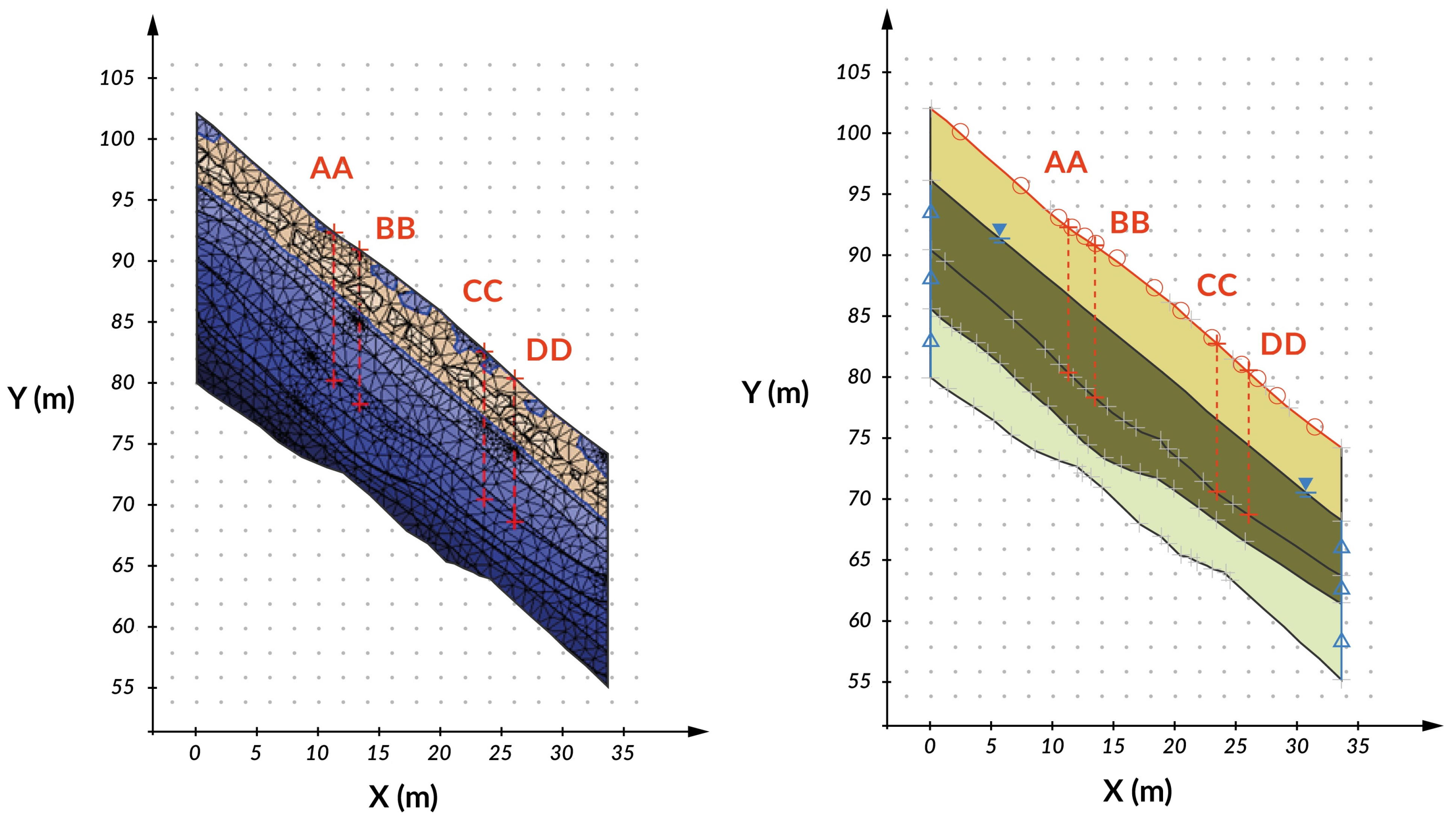

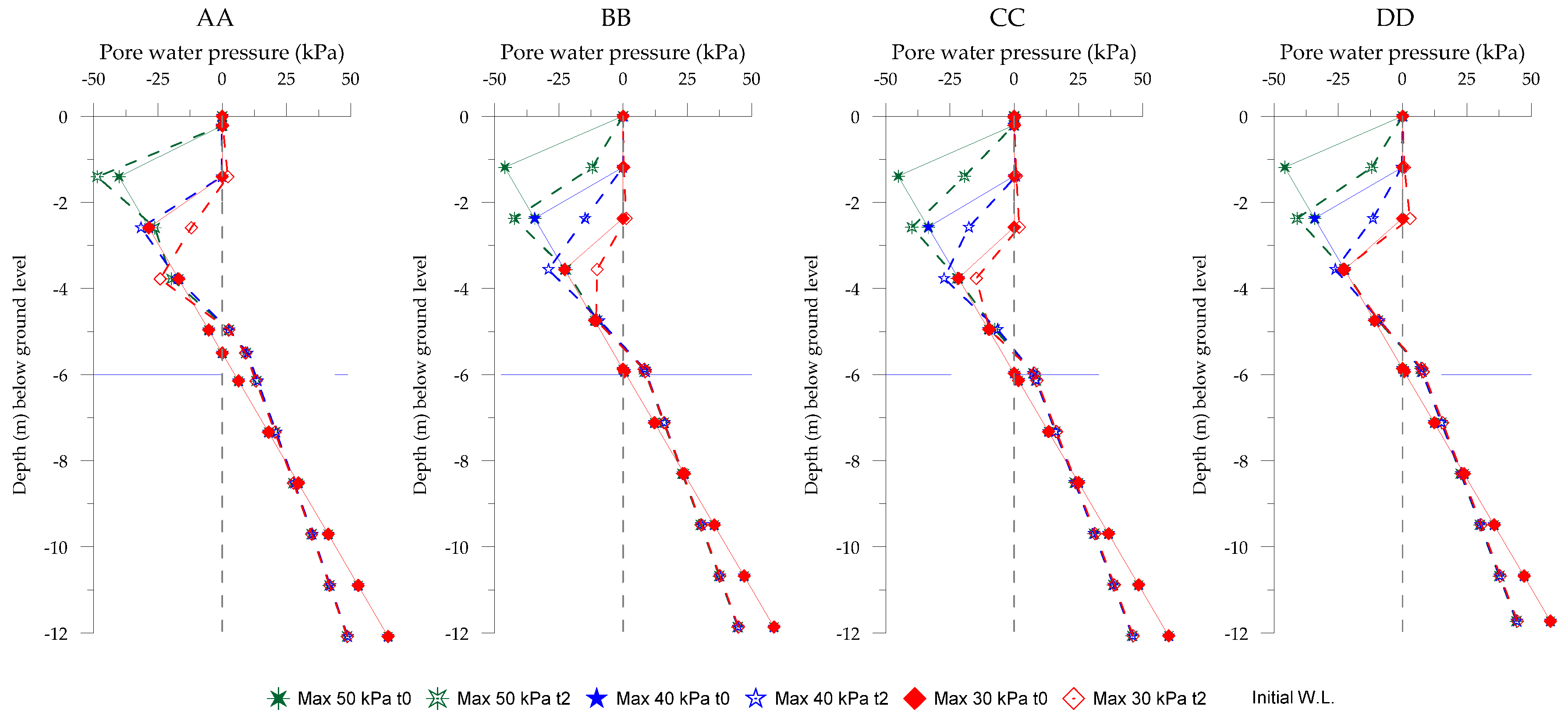

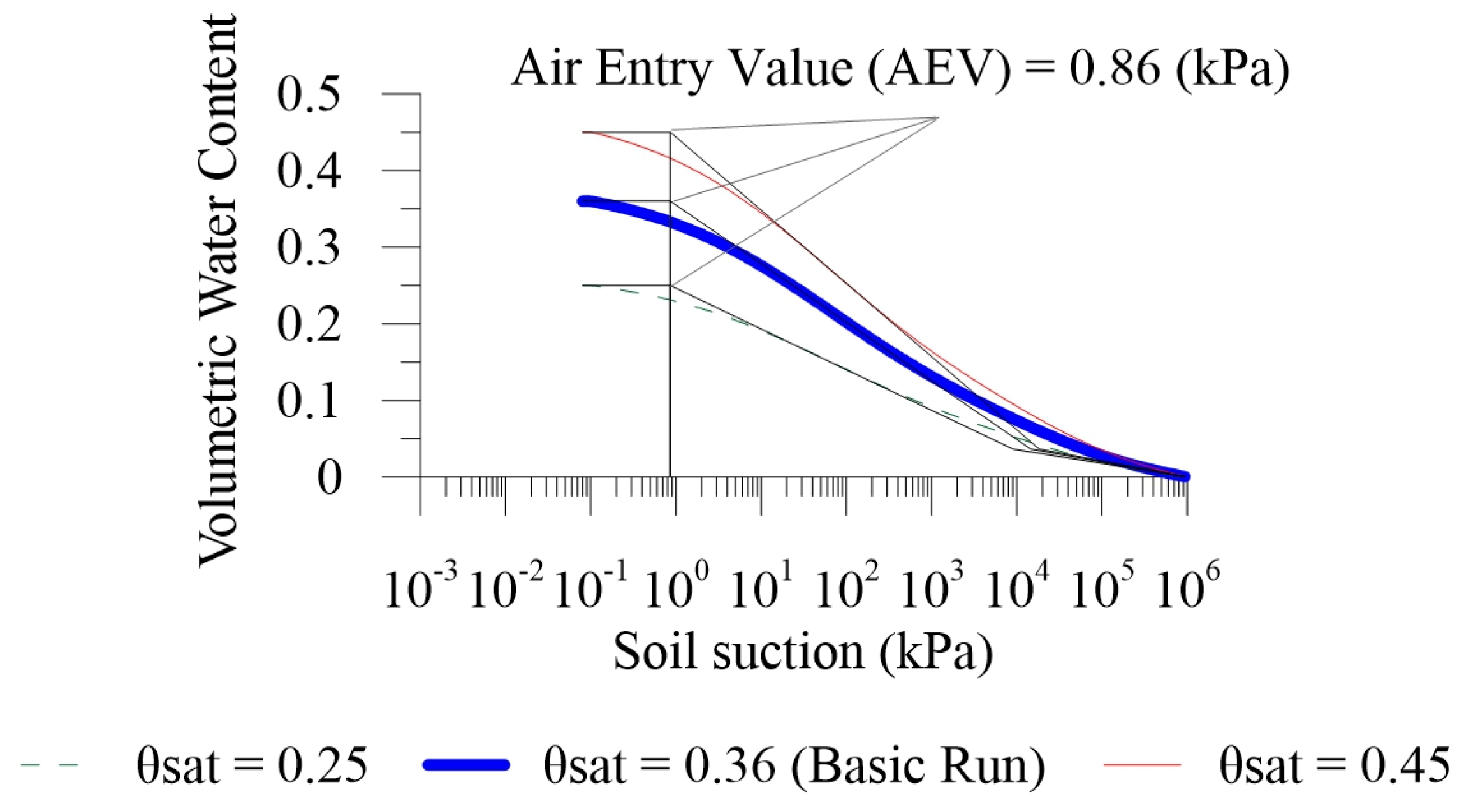
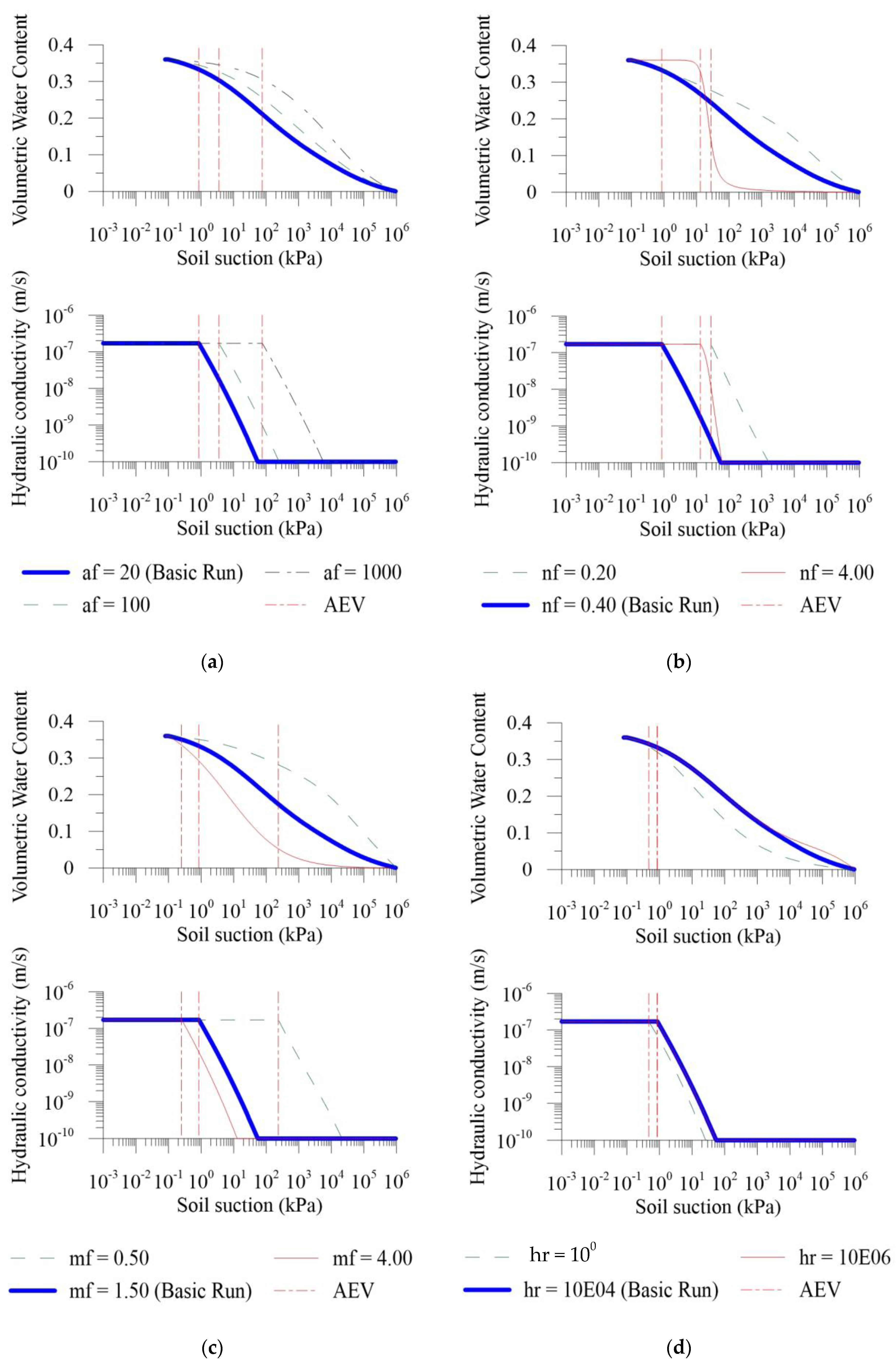
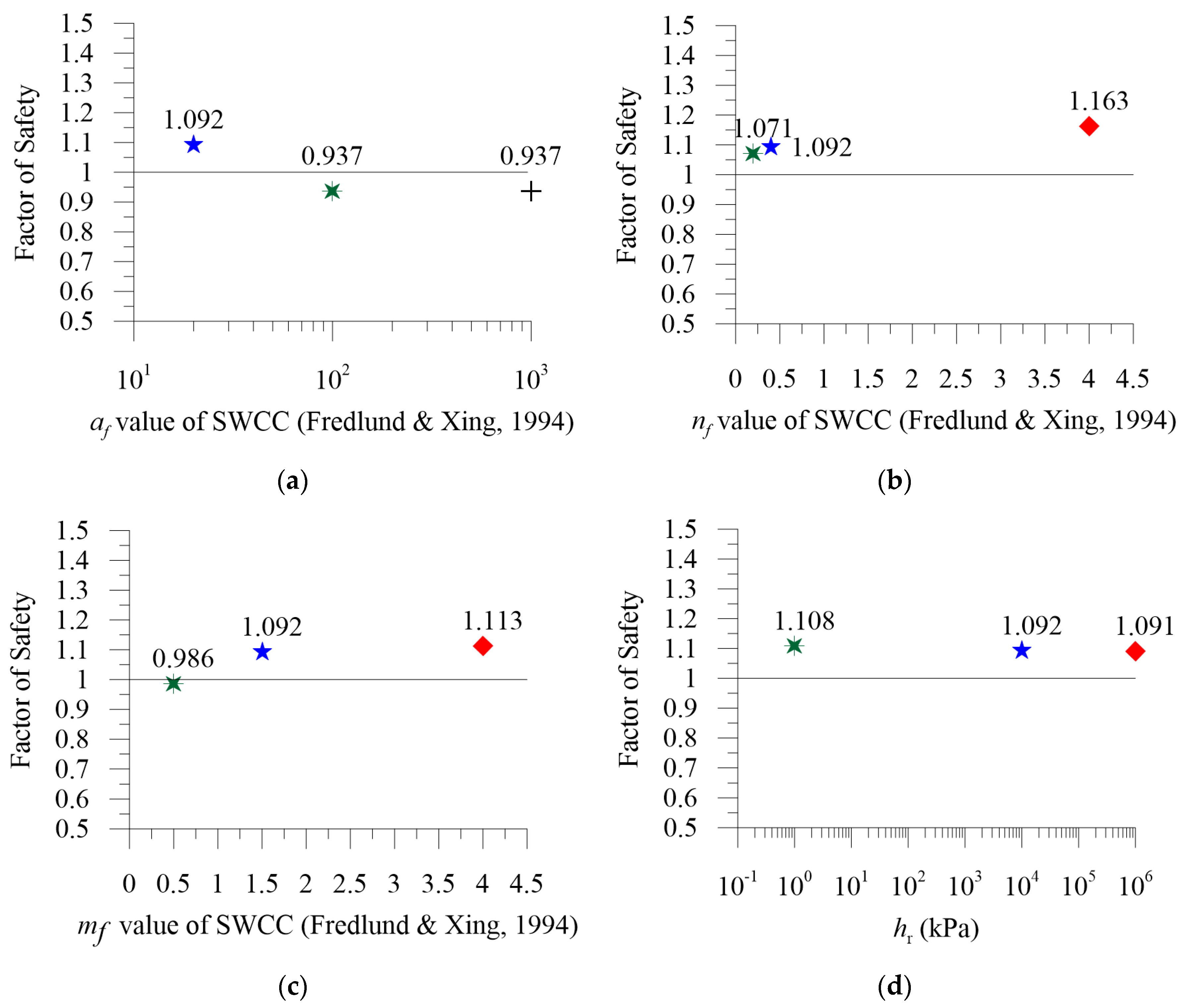
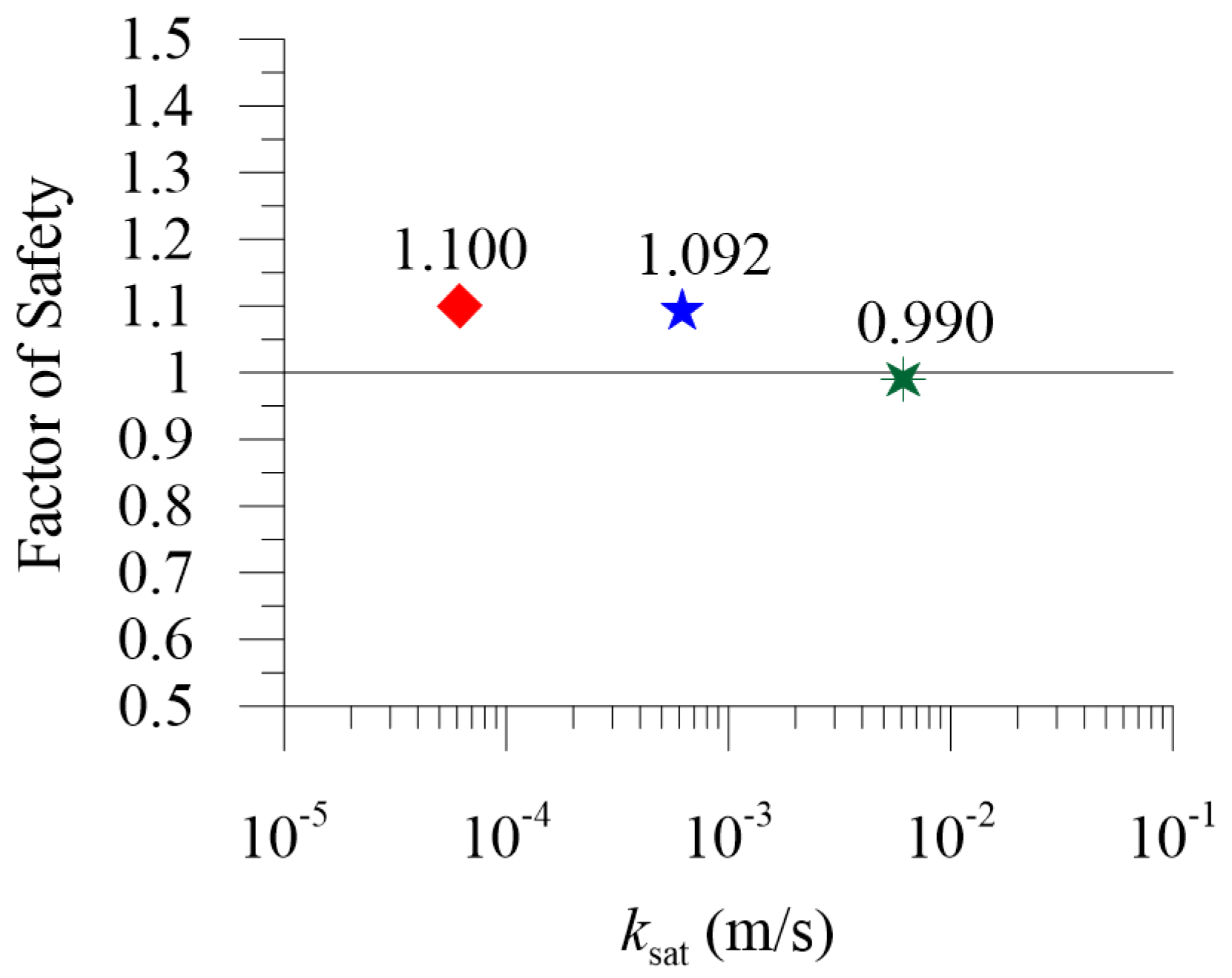

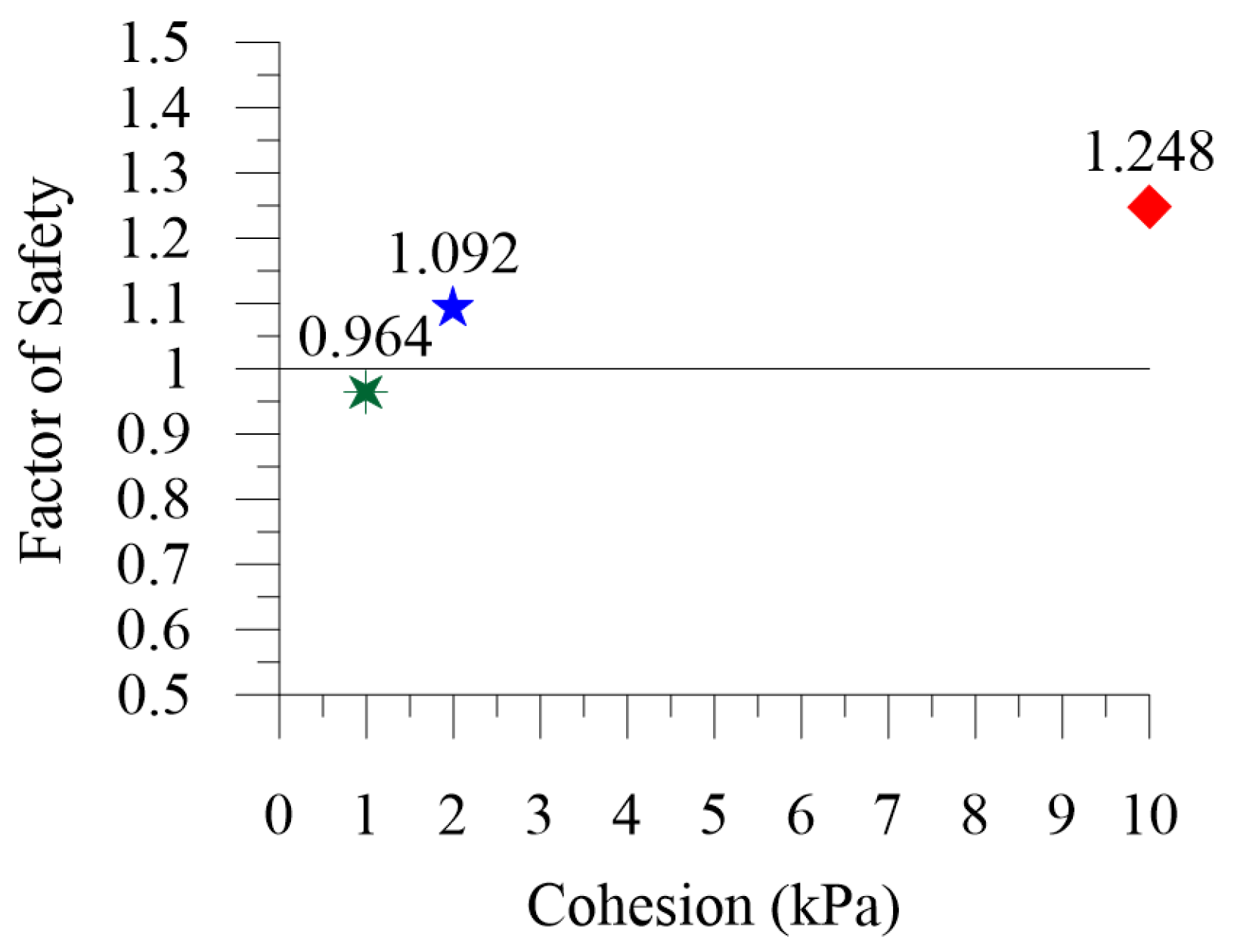
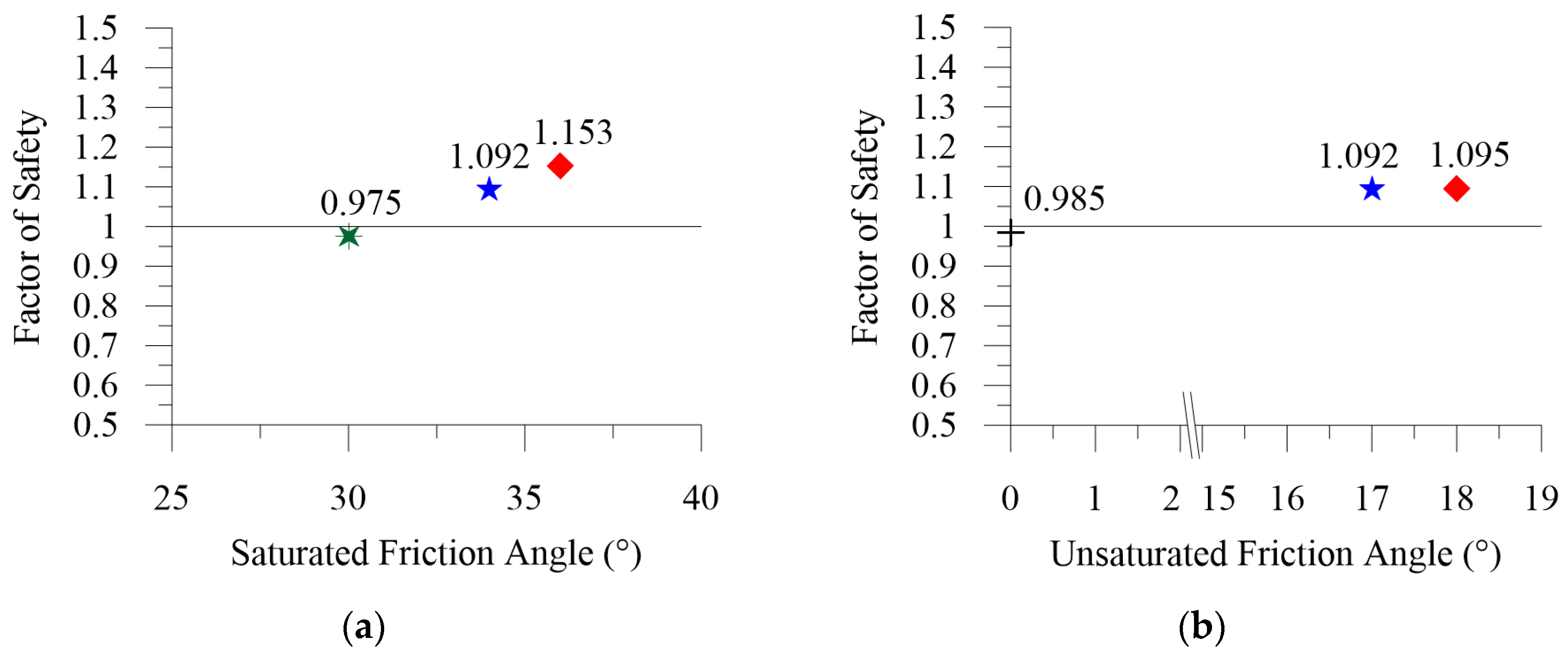
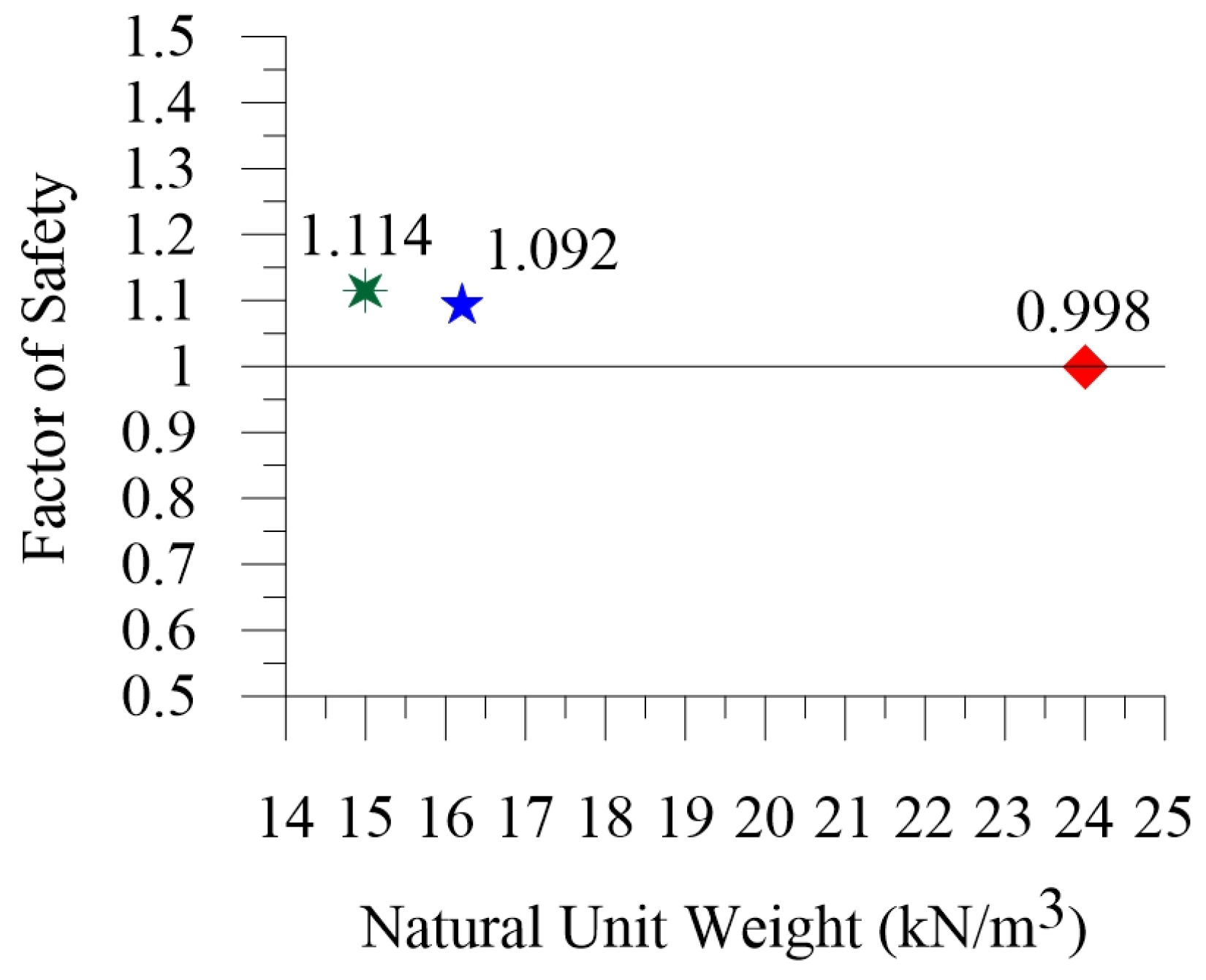
| Parameter | Reference Value | Reference | |
|---|---|---|---|
| Slope declivity (degrees) | 40 | [30,47] | |
| Maximum suction on unsaturated zone—ZAM a (kPa) | 40 | [52,54] | |
| θsat (porosity) | 0.36 | [53] b | |
| Fredlund and Xing fitting parameters | af (kPa) | 20 | [53] b |
| nf | 0.4 | [53] b | |
| mf | 1.5 | [53] b | |
| hr (kPa) | 10,000 | [53] b | |
| ksat (m/s) | 1.71 × 10−7 | [39] | |
| c′ (kPa) | 2 | [39] | |
| ϕ′ (degrees) | 34 | [39] | |
| ϕb (ϕ′/2) | 17 | [51] | |
| γ natural wet specific weight (kN/m3) | 16.20 | [39] | |
| Test | Declivity (o) | Maximum Suction Allowed (kPa) | SWCC (Fredlund and Xing Fitting Parameters) | ksat (m/s) | c′ (kPa) | ϕ′ (o) | ϕb (o) | γ (kN/m3) | |||||
|---|---|---|---|---|---|---|---|---|---|---|---|---|---|
| θsat | af | nf | mf | hr (kPa) | |||||||||
| Basic Run | 40 | ZAM * | 40 | 0.36 | 20 | 0.40 | 1.5 | 10,000 | 1.71 × 10−7 | 2 | 34 | 17 | 16.2 |
| S_01 | 30 | ZAM | 40 | 0.36 | 20 | 0.40 | 1.5 | 10,000 | 1.71 × 10−7 | 2 | 34 | 17 | 16.2 |
| S_02 | 50 | ZAM | 40 | 0.36 | 20 | 0.40 | 1.5 | 10,000 | 1.71 × 10−7 | 2 | 34 | 17 | 16.2 |
| S_03 | 40 | ZAM | 30 | 0.36 | 20 | 0.40 | 1.5 | 10,000 | 1.71 × 10−7 | 2 | 34 | 17 | 16.2 |
| S_04 | 40 | ZAM | 50 | 0.36 | 20 | 0.40 | 1.5 | 10,000 | 1.71 × 10−7 | 2 | 34 | 17 | 16.2 |
| S_05 | 40 | ZAM | 40 | 0.25 | 20 | 0.40 | 1.5 | 10,000 | 1.71 × 10−7 | 2 | 34 | 17 | 16.2 |
| S_06 | 40 | ZAM | 40 | 0.45 | 20 | 0.40 | 1.5 | 10,000 | 1.71 × 10−7 | 2 | 34 | 17 | 16.2 |
| S_07 | 40 | ZAM | 40 | 0.36 | 100 | 0.40 | 1.5 | 10,000 | 1.71 × 10−7 | 2 | 34 | 17 | 16.2 |
| S_08 | 40 | ZAM | 40 | 0.36 | 1000 | 0.40 | 1.5 | 10,000 | 1.71 × 10−7 | 2 | 34 | 17 | 16.2 |
| S_09 | 40 | ZAM | 40 | 0.36 | 20 | 0.20 | 1.5 | 10,000 | 1.71 × 10−7 | 2 | 34 | 17 | 16.2 |
| S_10 | 40 | ZAM | 40 | 0.36 | 20 | 4.00 | 1.5 | 10,000 | 1.71 × 10−7 | 2 | 34 | 17 | 16.2 |
| S_11 | 40 | ZAM | 40 | 0.36 | 20 | 0.40 | 0.5 | 10,000 | 1.71 × 10−7 | 2 | 34 | 17 | 16.2 |
| S_12 | 40 | ZAM | 40 | 0.36 | 20 | 0.40 | 4.0 | 10,000 | 1.71 × 10−7 | 2 | 34 | 17 | 16.2 |
| S_13 | 40 | ZAM | 40 | 0.36 | 20 | 0.40 | 1.5 | 1 | 1.71 × 10−7 | 2 | 34 | 17 | 16.2 |
| S_14 | 40 | ZAM | 40 | 0.36 | 20 | 0.40 | 1.5 | 1 × 106 | 1.71 × 10−7 | 2 | 34 | 17 | 16.2 |
| S_15 | 40 | ZAM | 40 | 0.36 | 20 | 0.40 | 1.5 | 10,000 | 1.71 × 10−6 | 2 | 34 | 17 | 16.2 |
| S_16 | 40 | ZAM | 40 | 0.36 | 20 | 0.40 | 1.5 | 10,000 | 1.71 × 10−8 | 2 | 34 | 17 | 16.2 |
| S_17 | 40 | ZAM | 40 | 0.36 | 20 | 0.40 | 1.5 | 10,000 | 1.71 × 10−7 | 1 | 34 | 17 | 16.2 |
| S_18 | 40 | ZAM | 40 | 0.36 | 20 | 0.40 | 1.5 | 10,000 | 1.71 × 10−7 | 10 | 34 | 17 | 16.2 |
| S_19 | 40 | ZAM | 40 | 0.36 | 20 | 0.40 | 1.5 | 10,000 | 1.71 × 10−7 | 2 | 30 | 17 | 16.2 |
| S_20 | 40 | ZAM | 40 | 0.36 | 20 | 0.40 | 1.5 | 10,000 | 1.71 × 10−7 | 2 | 36 | 17 | 16.2 |
| S_21 | 40 | ZAM | 40 | 0.36 | 20 | 0.40 | 1.5 | 10,000 | 1.71 × 10−7 | 2 | 34 | 0 | 16.2 |
| S_22 | 40 | ZAM | 40 | 0.36 | 20 | 0.40 | 1.5 | 10,000 | 1.71 × 10−7 | 2 | 34 | 18 | 16.2 |
| S_23 | 40 | ZAM | 40 | 0.36 | 20 | 0.40 | 1.5 | 10,000 | 1.71 × 10−7 | 2 | 34 | 17 | 15 |
| S_24 | 40 | ZAM | 40 | 0.36 | 20 | 0.40 | 1.5 | 10,000 | 1.71 × 10−7 | 2 | 34 | 17 | 24 |
| af | nf | mf | hr | AEV | ϕ′b |
|---|---|---|---|---|---|
| 20 | 0.4 | 4.0 | 10,000 | 0.25 | 0 |
| 20 | 0.4 | 1.5 | 1 | 0.47 | 0 |
| 20 | 0.4 | 1.5 | 1,000,000 | 0.84 | 0 |
| 20 | 0.4 | 1.5 | 10,000 | 0.86 | 0 |
| 1000 | 0.4 | 1.5 | 10,000 | 3.55 | 0 |
| 20 | 4.0 | 1.5 | 10,000 | 13.06 | 15 |
| 20 | 0.2 | 1.5 | 10,000 | 27.58 | 15 |
| 100 | 0.4 | 1.5 | 10,000 | 76.28 | 15 |
| 20 | 0.4 | 0.5 | 10,000 | 237.19 | ϕ′ |
| Parameter | ΔF.S./Δparameter (%) a |
|---|---|
| Slope inclination | 146 |
| Initial suction condition | 38 |
| θsat | 7 |
| af | 0.2 |
| nf | 2 |
| mf | 8 |
| hr | 0.7 |
| ksat | 0.9 |
| Cohesion | 13 |
| Friction angle | 93 |
| Unsaturated friction angle | 7 |
| Specific weight | 22 |
Publisher’s Note: MDPI stays neutral with regard to jurisdictional claims in published maps and institutional affiliations. |
© 2022 by the authors. Licensee MDPI, Basel, Switzerland. This article is an open access article distributed under the terms and conditions of the Creative Commons Attribution (CC BY) license (https://creativecommons.org/licenses/by/4.0/).
Share and Cite
Oliveira, E.d.P.; Acevedo, A.M.G.; Moreira, V.S.; Faro, V.P.; Kormann, A.C.M. The Key Parameters Involved in a Rainfall-Triggered Landslide. Water 2022, 14, 3561. https://doi.org/10.3390/w14213561
Oliveira EdP, Acevedo AMG, Moreira VS, Faro VP, Kormann ACM. The Key Parameters Involved in a Rainfall-Triggered Landslide. Water. 2022; 14(21):3561. https://doi.org/10.3390/w14213561
Chicago/Turabian StyleOliveira, Elisangela do Prado, Andrés Miguel González Acevedo, Virnei Silva Moreira, Vitor Pereira Faro, and Alessander Christopher Morales Kormann. 2022. "The Key Parameters Involved in a Rainfall-Triggered Landslide" Water 14, no. 21: 3561. https://doi.org/10.3390/w14213561
APA StyleOliveira, E. d. P., Acevedo, A. M. G., Moreira, V. S., Faro, V. P., & Kormann, A. C. M. (2022). The Key Parameters Involved in a Rainfall-Triggered Landslide. Water, 14(21), 3561. https://doi.org/10.3390/w14213561








